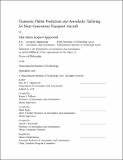Transonic flutter prediction and aeroelastic tailoring for next-generation transport aircraft
Author(s)
Opgenoord, Max Maria Jacques
DownloadFull printable version (16.62Mb)
Other Contributors
Massachusetts Institute of Technology. Department of Aeronautics and Astronautics.
Advisor
Karen E. Willcox and Mark Drela.
Terms of use
Metadata
Show full item recordAbstract
Novel commercial transport aircraft concepts feature large wing spans to increase their fuel efficiency; these wings are more flexible, leading to more potential aeroelastic problems. Furthermore, these aircraft fly in the transonic flow regime, where utter prediction is difficult. The goals for this thesis are to devise a method to reduce the computational burden of including transonic utter constraints in conceptual design tools, and to offer a potential solution for mitigating utter problems through the use of additive manufacturing techniques, specically focusing on a design methodology for lattice structures. To reduce the computational expense of considering transonic utter in conceptual aircraft design, a physics-based low-order method for transonic utter prediction is developed, which is based on small unsteady disturbances about a known steady flow solution. The states of the model are the circulation and doublet perturbations, and their evolution equation coefficients are calibrated using off-line unsteady two-dimensional flow simulations. The model is formulated for swept high-aspect ratio wings through strip theory and 3D corrections. The resulting low-order unsteady flow model is coupled to a typical-section structural model (for airfoils) or a beam model (for wings) to accurately predict utter of airfoils and wings. The method is fast enough to permit incorporation of transonic utter constraints in conceptual aircraft design calculations, as it only involves solving for the eigenvalues of small state-space systems. This model is used to describe the influence of transonic utter on next generation aircraft configurations, where it was found that transonic utter constraints can limit the eciency gains seen by better material technology. As a potential approach for mitigating utter, additively manufactured lattice structures are aeroelastically tailored to increase the flutter margin of wings. Adaptive meshing techniques are used to design the topology of the lattice to align with the load direction while adhering to manufacturing constraints, and the lattice is optimized to minimize the structural weight and to improve the flutter margin. The internal structure of a wing is aeroelastically tailored using this design strategy to increase the flutter margin, which only adds minimal weight to the structure due to the large design freedom the lattice structure offers.
Description
Thesis: Ph. D., Massachusetts Institute of Technology, Department of Aeronautics and Astronautics, 2018. This electronic version was submitted by the student author. The certified thesis is available in the Institute Archives and Special Collections. Cataloged from student-submitted PDF version of thesis. Includes bibliographical references (pages 121-141) and index.
Date issued
2018Department
Massachusetts Institute of Technology. Department of Aeronautics and AstronauticsPublisher
Massachusetts Institute of Technology
Keywords
Aeronautics and Astronautics.